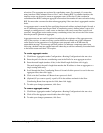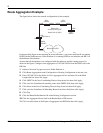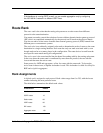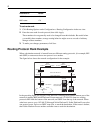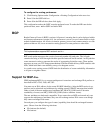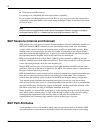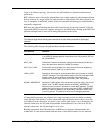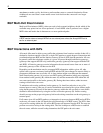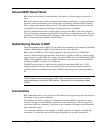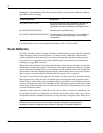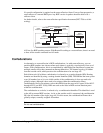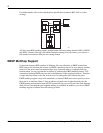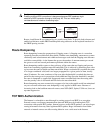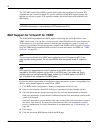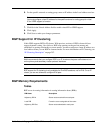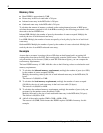
Nokia Network Voyager for IPSO 4.0 Reference Guide 407
Inbound BGP Route Filters
BGP routes can be filtered, or redistributed by AS number or AS path regular expression, or
both.
BGP stores rejected routes in the routing table with a negative preference. A negative preference
prevents a route from becoming active and prevents it from being installed in the forwarding
table or being redistributed to other protocols. This behavior eliminates the need to break and
re-establish a session upon reconfiguration if importation policy is changed.
The only attribute that can add or modify when you import from BGP is the local preference.
The local preference parameter assigns a BGP local preference to the imported route. The local
preference is a 32-bit unsigned value, with larger values preferred. This is the preferred way to
bias a routing subsystem preference for BGP routes.
Redistributing Routes to BGP
When redistributing routes to BGP, you can modify the community, local preference, and MED
attributes. Redistribution to BGP is controlled on an AS or AS path basis.
BGP 4 metrics (MED) are 32-bit unsigned quantities; they range from 0 to 4294967295
inclusive, with 0 being the most desirable. If the metric is specified as IGP, any existing metric
on the route is sent as the MED. For example, this allows OSPF costs to be redistributed as BGP
MEDs. If this capability is used, any change in the metric causes the route to be redistributed
with the new MED, or to flap, so use it with care.
The BGP local preference is significant only when used with internal BGP. It is a 32-bit
unsigned quantity and larger values are preferred. The local preference should normally be
specified within the redistribution list unless no BGP sources are present in the redistribution
list.
Note
If BGP routes are being redistributed into IBGP, the local preference cannot be overridden,
and this parameter is ignored for IBGP sources. The same is true for confederation peers
(CBGP).
Communities
BGP communities allow you to group a set of IP addresses and apply routing decisions based on
the identity of the group or community.
To implement this feature, map a set of communities to certain BGP local preference values.
Then you can apply a uniform BGP configuration to the community as a whole as opposed to
each router within the community. The routers in the community can capture routes that match
their community values.
Use community attributes to can configure your BGP speaker to set, append, or modify the
community of a route that controls which routing information is accepted, preferred, or



